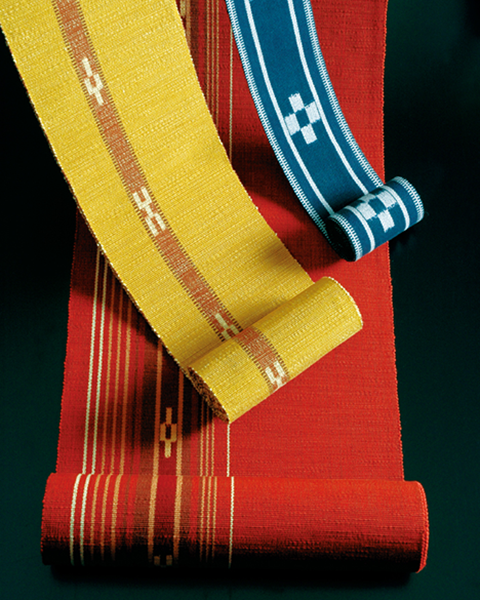About Yaeyama Minsah-ori Obi Belts
The Minsau which has been weaved since ancient times, was a gift presented by a lady to the man she loved as a sign of the consummation of engagement. It was a thin piece of indigo-dyed (Ryukyu indigo) obi belt with five and four-square Kasuri patterns to express that her love would last “forever for eternity.”
By combining natural plant dye colors into the conventional indigo-only Minsau, the museum’s director Kinue Ara, a Contemporary Master Craftsman, created a new world of Yaeyama Minsah-ori.
Modern obi belts are available in a wide variety of designs and colors, including Yonsun Obi, Hassun Obi, and Kaku Obi. The Hassun Obi and Kyusun Obi are both made of cotton, but they are also available in silk and linen, and the materials used to make obi belts are becoming more varied.
However, one thing that has not changed is the Minsau, which is still an essential part of local traditional events. Then there are the five-and-four square Kasuri patterns and their meanings and values, which will be passed down carefully as unchanging.

About Yaeyama jofu
Yaeyama jofu is a fabric used to be produced as a tax to the Ryukyu Kingdom (current Okinawa). It has been woven as a refined fine cloth over time.
Yaeyama jofu’s origin is unknown, but it is the oldest known woven linen fabric and was required by the Yaeyama Islands in 1673 as an official cloth (tribute cloth) during the royal government period. The clothes supplied to the government included white upper cloth and red striped upper cloth (there were also inner and lower cloth). And today, as refined jofu (upper cloth), a traditional handcraft, they are still weaved after a history of heavy manpower taxes that lasted until 1903.

About Gunbo (mixed fabric)
Weft and warp threads in this mixed-woven fabric are weaved from different materials.
The warp is woven with cotton threads and the weft is made using Ramie, Basho (banana fibers), silk, and various other materials.
Gunbo, as opposed to jofu, which was gifted to the Ryukyu Dynasty, has long been familiar to the people of Yaeyama and has been used as a more practical fabric to make kimono.
This textile has been popular in Yaeyama for a long time and contains the wisdom and ingenuity of our ancestors.


